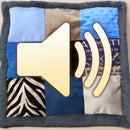Introduction: Closet Sewing Space
Usually, I tackle a project by recognizing a need, and then go about problem solving. In this case, I had a want... and it took me a few minutes to realize it was also a perfect solution!
I fell in love with a small arts and crafts style desk at a local auction. But I couldn't really justify buying it, without having a use for it. Thankfully,right before the bidding began, I realized it would probably fit perfect in my closet in the art room upstairs. Sigh... I now had an idea, and a reason!
I won the desk (for a steal), and the sewing nook was born!
I fell in love with a small arts and crafts style desk at a local auction. But I couldn't really justify buying it, without having a use for it. Thankfully,right before the bidding began, I realized it would probably fit perfect in my closet in the art room upstairs. Sigh... I now had an idea, and a reason!
I won the desk (for a steal), and the sewing nook was born!
Step 1: Organizational Tools
A couple of organization tools really helped me with this space.
Small Desk
I lucked out, saw the desk first and it fit (we'll call it a good eye, and not mention the luck to my husband).... I would recommend measuring your closet, and checking out a goodwill, or your kiddo's room.
Peg board
I had never put up any peg board before, so that was an adventure, but it wasn't so hard.
You'll need:
I like the see though ones, so I don't have to open all the boxes to find what I'm looking for.
Door Rack
I got one of those "elfa" door rack systems you can get at the container store. It wasn't cheap, but it has now lasted me over 5 years, no scratches... no problems.
- A small desk
- The peg board !! (big time)
- Plastic see through bins
- Door hanging basket system.
Small Desk
I lucked out, saw the desk first and it fit (we'll call it a good eye, and not mention the luck to my husband).... I would recommend measuring your closet, and checking out a goodwill, or your kiddo's room.
Peg board
I had never put up any peg board before, so that was an adventure, but it wasn't so hard.
You'll need:
- peg board
- 1x2 wood. ( 1 x 2 actually measures about 3/4" x 1 1/2")
- Wood screws long enough to go through the 3/4" wood, and in to your studs behind the wall. (about 12 of them)
- Shorter screws to screw the peg board to the wood. (again 9 - 12)
- Circular saw for cutting.
- Drill
- Measure up how big you want to the peg board to be.
- Buy pegboard, I got a 1/4 sheet at home depot, and cut off the extra at home with a circular saw.
- The peg board needs to sit away from the wall so the hooks can slide in. That's where the 1x2 comes in.
- I bought 8 feet of the 1x2, and cut it down to 3, 24" pieces. The 24" was the height of my peg board. And I cut 3, so I could put one on each side, and one on the stud in the middle. Change your measurements to suit your space, adding 1x2 framing on every stud, as it gets wider.
- To screw the 1x2's in to the walls. I pre-drilled holes with a drill bit, just smaller than my screws. Then I screwed the wood to the wall. Make sure you are screwing in to a stud, or use dry wall anchors (in that case I would be sure not to put heavy things on the peg board)
- Screw the peg board to the 1x2 framing. You could put a piece of 1x2 on top for extra stability. I don't put one on the bottom, because some how little things get trapped back there !?!
- Get hooks to suit your needs, and your off!
I like the see though ones, so I don't have to open all the boxes to find what I'm looking for.
Door Rack
I got one of those "elfa" door rack systems you can get at the container store. It wasn't cheap, but it has now lasted me over 5 years, no scratches... no problems.
Step 2: Accessories
There are also a few handy accessories in this space.
I made this by cutting up some of a bamboo cutting board. I then nailed long nails in to the board, I eyeballed the spacing to accommodate the bobbins. I also screwed an eye hook in to the top, so I could hang it on one of the peg board hooks.
Mini Shelf
Using remaining parts of the bamboo cutting board I cut it, so that it would sit well on some of the peg board hangers that stick right out.
Portable pin Cushion
This is my cat's favorite attraction.. he likes to steal the pins and then run for it!
(I cannot tell you how many times I have had to chase my cat around the house yelling like a mad woman, trying to grab the cat, and snatch the pin from his mouth. I imagine, he's laughing the whole time!)
To help me put the pin cushion in a safe place, I added 2 eye screws to it, and some picture hanging wire. I can now hang it up off the table, easy for me to reach, and in my line of sight.
Patterns on a String
I create templates, when I make new designs. The templates that I use most often all have a hole punched through them, so I can put them on a string, and hang them up. Easy for me to reach, and find.
- Bobbin Rack
- mini shelf
- portable / hang-able pin cushion
- patterns on a string
I made this by cutting up some of a bamboo cutting board. I then nailed long nails in to the board, I eyeballed the spacing to accommodate the bobbins. I also screwed an eye hook in to the top, so I could hang it on one of the peg board hooks.
Mini Shelf
Using remaining parts of the bamboo cutting board I cut it, so that it would sit well on some of the peg board hangers that stick right out.
Portable pin Cushion
This is my cat's favorite attraction.. he likes to steal the pins and then run for it!
(I cannot tell you how many times I have had to chase my cat around the house yelling like a mad woman, trying to grab the cat, and snatch the pin from his mouth. I imagine, he's laughing the whole time!)
To help me put the pin cushion in a safe place, I added 2 eye screws to it, and some picture hanging wire. I can now hang it up off the table, easy for me to reach, and in my line of sight.
Patterns on a String
I create templates, when I make new designs. The templates that I use most often all have a hole punched through them, so I can put them on a string, and hang them up. Easy for me to reach, and find.
Step 3: Lighting
This is one of my least elegant solutions... but also one of my cheapest :-)
A closet space can be pretty dim, making it hard to see thread colors, and black on black stitching. This space needed some light! Thankfully, this is a "Harry Potter" style closet, in that it is under the stairs. I was able to place a lamp next to my desk. So now I can see what I'm doing. (OK, it's pretty gaudy... but for less than a buck, I can hardly complain, and no one else sees it ).
Behind the lamp I still have some storage for items I don't need frequent access to.
A closet space can be pretty dim, making it hard to see thread colors, and black on black stitching. This space needed some light! Thankfully, this is a "Harry Potter" style closet, in that it is under the stairs. I was able to place a lamp next to my desk. So now I can see what I'm doing. (OK, it's pretty gaudy... but for less than a buck, I can hardly complain, and no one else sees it ).
Behind the lamp I still have some storage for items I don't need frequent access to.
Step 4: Ta Daa!
The nice thing about this space is that I created a little over 2 years ago, and it is still working for me now. It is a pleasure to sit down, and know my supplies are at my fingertips, or within arms reach. It has also been fairly easy to maintain. Aside from keeping out the cats, being able to close the door has also meant that I can leave a project sitting out, and it's waiting for me when I come back... undisturbed!!
This little closet is hands down one of my favorite places to sit and work. And I hope sharing it helps inspire you to carve out a space for yourself. :-)






